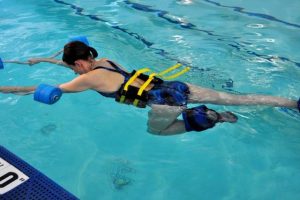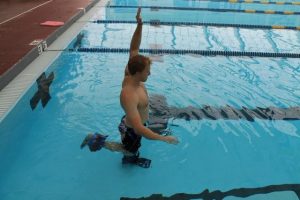 The most common symptoms a client experiences after undergoing a total joint replacement are pain, swelling, stiffness, muscle weakness and limited activities of daily living.
The most common symptoms a client experiences after undergoing a total joint replacement are pain, swelling, stiffness, muscle weakness and limited activities of daily living.
Traditional rehabilitation for patients following a total joint replacement typically involves some combination of range of motion, strengthening, ADL, gait training, functional training and patient education.
Aquatic rehabilitation offers an alternative intervention to traditional rehabilitation following a total joint replacement. There are many reported benefits of Aquatic Therapy and by integrating aquatic therapy into traditional land based therapy I have found that this type of protocol is very beneficial to my clients.
Why Incorporate Aquatic Therapy into Total Joint Rehab?
Moving Easier and More Functionally
By taking advantage of water’s unique properties of buoyancy and hydrostatic pressure the client will have less pain and reduced swelling. Because the client is much more unloaded in the water than on land it is much easier to help correct abnormal gait patterns. Clients are able to improve weight shift and alignment therefore facilitating a more normal gait pattern that then will be transferred to land.
Restoring Range of Motion (ROM)
Buoyancy unloads the joint and assists with range of motion, more importantly the client has control over their movement. This reduces apprehensiveness significantly which then reduces muscle guarding. In my experience I have found that after an aquatic session a client will typically have a 5-10 degree increase in ROM. This is then an opportune time to perform manual stretching and gentle strengthening on land so that the newly gained range of motion can be improved even more.
Increased Balance
Balance exercises can be be started much earlier in the water. The water provides increases kinesthetic feedback and is more forgiving if one tends to lose their balance. The waters viscosity provides a latency period so delayed reaction time can be trained safely and functionally.
 Improved Strength
Improved Strength
Strengthening exercise performed in the water are very safe and effective. Water provides an accommodating resistance so the faster the client moves thought the water the more resistance they will receive. Also as soon as the client stops contracting the muscle the movement will cease because of the diminished effects of gravity.
By performing functional exercises in the aquatic environment is it very easy to transfer these to the gym.
I had the opportunity a few years ago to perform a research study with total knee replacement patients. I incorporated and integrated (pool and land) protocol and compared it to a strictly land protocol. After a 6 week time period the integrated group had demonstrated a greater improvement in knee range of motion as well as function.
I know that we live on land and we do not live in the water but I like to compare water and land based training to peanut butter and jelly. If used alone they are both good but if they are combined then they are fantastic.
If you’re interested in sponsoring a Medically Based Aquatics (MBA) course at your facility please contact Rick McAvoy at rick@rickmcavoyaquatics.com
Dr. Rick McAvoy has specialized in Aquatic Physical Therapy and Sports Performance for over 25 years and promotes aquatic fitness, rehab and training. He is the Owner of RMA (Rick McAvoy Aquatics), an Aquatic Fitness and Sports Performance Training and Consulting Company. Rick is also a published author and researcher in the field of Aquatic Therapy and Fitness as well as Sports Performance.

